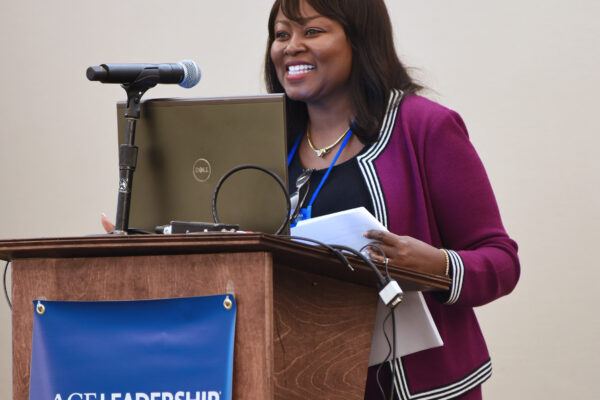By Jessica Egbert
The ACE Women’s Network started in 1977 as a national “network of networks,” including networks from each state, Puerto Rico, and the District of Columbia, with the goal of advancing and supporting women in higher education. This post is the first in a series highlighting the innovative efforts and successes of state networks across the country. Use the hashtag #ACEWomensNetwork to share your thoughts and ideas on social media.
Utah is a place of exceptions: exceptionally beautiful and diverse landscapes; exceptionally high volunteerism; exceptionally high quality healthcare; exceptionally healthy economy; exceptionally educated population; and exceptionally low unemployment. Unfortunately, it is also a place where pay equity and leadership opportunities for women have been exceptionally poor. However, with the support of a volunteer Board of Directors and the advocacy and mentorship of presidential sponsors, the Utah Women in Higher Education Network (UWHEN; ACE Women’s Network Utah State Network) has helped begin to turn this around on college and university campuses across the state.
 The complex charge of advancing women’s leadership in higher education requires strategic initiatives, effective communication and engaged leadership. Essential to UWHEN’s strategy was increasing the awareness and commitment of higher education leaders to ACE’s Moving the Needle: Advancing Women in Higher Education Leadership initiative, a collaborative, multi-association effort to increase the number of women in senior leadership positions in higher education. As such, the UWHEN Board of Directors adopted the goal of increasing the number of Utah institutions that had taken the pledge. At the start of this goal, just over 42 percent of UWHEN member institution presidents had signed the pledge. This number has now risen to nearly 86 percent—and we are hopeful for additional signers.
The complex charge of advancing women’s leadership in higher education requires strategic initiatives, effective communication and engaged leadership. Essential to UWHEN’s strategy was increasing the awareness and commitment of higher education leaders to ACE’s Moving the Needle: Advancing Women in Higher Education Leadership initiative, a collaborative, multi-association effort to increase the number of women in senior leadership positions in higher education. As such, the UWHEN Board of Directors adopted the goal of increasing the number of Utah institutions that had taken the pledge. At the start of this goal, just over 42 percent of UWHEN member institution presidents had signed the pledge. This number has now risen to nearly 86 percent—and we are hopeful for additional signers.
Simultaneous to this work, UWHEN members (myself included) participated in the annual ACE Women’s Network State Chairs’ Leadership Conference, which prompted the following question: although Moving the Needle was primarily orchestrated for colleges and universities, have we reached out to policy leaders outside of higher education? Realizing key influencers may be unaware of the initiative, UWHEN led the charge to connect with state policy leaders, specifically, Utah Governor Gary R. Herbert.
UWHEN reached Governor Herbert, a recognized advocate for women in leadership through his support of the Women’s Leadership Institute’s ElevateHER Challenge, through a supportive contact (Val Hale, director of the Governor’s Office of Economic Development) and through the Governor’s exceptional executive assistant, Fran Stultz. UWHEN drafted a letter providing background information on our efforts, including a specific request: for the Governor to support Moving the Needle and provide a letter to encourage the same of policy and educational leaders throughout Utah and across the United States. I signed the request along with three institutional presidents: Deneece Huftalin (Salt Lake Community College; 2014-17 UWHEN presidential sponsor); Richard Williams (Dixie State University; 2017-20 UWHEN presidential sponsor); and Richard P. Nielsen (Rocky Mountain University of Health Professions; UWHEN Board Chair’s home institution).
Following the submission, the Governor’s office requested a draft letter, which we provided. UWHEN received the official response from the Governor’s office shortly thereafter, the entire process taking less than one month. In addition to the social media and email distribution by UWHEN, the letter was circulated by the Women’s Leadership Institute, ACE, the Utah System of Higher Education, several academic institutions, and the local media wrote a followup article.
While UWHEN continues its efforts to increase the quantity of institutions committed to Moving the Needle, the process thus far and the support from Governor Herbert resulted in several takeaways on how UWHEN was effective in reaching its goal:
- Context is important. Utah has a relatively small quantity of higher education institutions and vast geographic boundaries. Each state network has its own roadblocks.
- Promote the power of ACE affiliation. Connecting the state network to the national association adds credibility.
- Challenge and empower board members in shared goals. Individual board members were essential to the Moving the Needle progress.
- Connect the 5Ps. Private institutions, Public institutions, Presidents, Politicians, and Press.
- Use tag-teams. Having two board members from each institution focused on the same initiative was effective in educating and obtaining presidential support.
- Know the assistant (and treat him or her well). If you need to get on the calendar of an institutional president or policy influencer without having a direct connection, get to know his or her assistant. The assistant is a source of great knowledge and access.
- Make good use of the presidential sponsor(s). These institutional leaders are incredible sources of support, influence, and expertise. Don’t be afraid to ask for help!
Above all, don’t get discouraged. Would UWHEN have liked to have 100 percent of presidents from Utah institutions sign the Moving the Needle pledge? Absolutely. However, it’s important to take time to acknowledge successes and get creative at climbing over walls. After all, the journey to having 50 percent of U.S. college and university presidencies filled by women by 2030 is not one that is travelled overnight. By uniting regional, state, and national efforts, our collective work creates pathways to leadership and builds pipelines of qualified candidates for future generations of higher education leaders.

10 Strategies for Success
1. Support Your Audience. UWHEN includes women across all higher education roles (faculty, staff and administration). While some state networks focus on staff and administration, similarly identified issues in faculty promotion and tenure may serve a catalyst for expanding the audience. UWHEN serves the faculty population by ensuring they serve on the UWHEN Board of Directors and including topics of faculty interest at events.
2. Connect with Leaders. UWHEN has a presidential sponsor whose role is advocacy and mentorship. Current and past presidential sponsors have been remarkably supportive, helping UWHEN make effective decisions and advocating shared goals across the Utah System of Higher Education (USHE). The presidential sponsor presents to the USHE Council of Presidents an annual report reflecting the mission-fulfillment activities of UWHEN, related activities on each member institution’s campus, and requests for support from ACE.
3. Include State Systems of Higher Education. Because USHE is in a position of influence and a supporter of UWHEN initiatives, two ex oficio seats are held on the UWHEN Board for USHE leaders. Although USHE is a non-paying member of UWHEN, Board members serve in strategic advisement and support roles.
4. Address Regional Needs. While Utah has relatively few higher education institutions, those institutions span a wide geography. As such, UWHEN hosts three regional events each fall on different campuses. Additionally, each member institution has access to grant funding through UWHEN toward a leadership-related campus event. Finally, several institutional members have formed campus UWHEN chapters that provide grassroots support to their employees.
5. Integrate Public and Private Institutions. The UWHEN Board of Directors consists of 36 representatives from 14 member institutions (eight public institutions, the technology college system, and five private institutions) and the Utah System of Higher Education. By integrating diverse institutions, UWHEN continuously builds its network, expands innovation and serves a greater number of women in higher education.
6. Manage Your Money. Adequate funding is essential to UWHEN fulfilling its overarching mission. Each member institution pays an annual rate based on the student FTE. When UWHEN expanded funding beyond membership fees and added paid and in-kind sponsorships, the network grew the size and scope of events, increased campus grants, added professional development grants, outsourced a website overhaul (currently underway) and logo revision and purchased materials. Increased awareness and positive experiences resulted in stronger constituent engagement with UWHEN.
7. Look Outside of Your Network. By seeking diverse experts in politics, business, and non-profits, UWHEN has found powerful speakers and workshop facilitators, as well as built connections to leaders and potential sponsors. Alignment with like-minded organizations has also moved forward UWHEN’s initiatives through increased awareness and shared goals. For example, UWHEN connects with organizations such as the Utah Women and Leadership Project, Real Women Run, and the Women’s Leadership Institute.
8. Use Your Data. Within each annual report, UWHEN provides quantitative and qualitative data on institutional member initiatives related to UWHEN mission fulfillment. The report is presented to the USHE Council of Presidents and provided to the ACE Women’s Network. This accountability measure increases credibility while also helping UWHEN tell its story.
9. Diversify Marketing and Communication Strategies. To address the diverse generations of women employed in higher education, UWHEN needed to diversify marketing and communication strategies. Among these initiatives were an expanded social media presence, branded emails, automated email list sign-up, Facebook ads, improved and increased imagery, livestreaming conference keynote presenters, online registration, web-based data collection and reporting, and updating the logo and website. Through enhanced sophistication and savviness of marketing and communication efforts, UWHEN expanded its reach, engaged its audience, achieved registration goals, and improved capacity to address the needs of its constituents.
10. Engage in Board Development and Continuity Planning. The UWHEN Board of Directors is essential to the organization’s success. Board members are responsible for communicating information on respective campuses to develop grassroots interest and awareness in UWHEN. Because UWHEN does not have access to employee lists from campuses (one of our greatest challenges), Board members must educate employees about events, services and resources. A new attendee to a successful UWHEN event will likely convert from being a one-time-attendee to a long-term participant. UWHEN Board members generally serve three year, staggered, renewable terms and each institutional member is invited to have two Board members.
While the ACE Women’s Network State Chair Handbook indicates university and college presidents should appoint the board, we have discovered this level of engagement with a president is less likely and have found greater success by soliciting board membership through personal connections, interested members and referrals. While the Board has vacillated in its use of committees, a recent revision of committees, committee charges, and specific duties reengaged the Board’s work in meaningful ways by ensuring each person has a role and that the talents of each Board member individually contribute to UWHEN’s success. Board members should be empowered to own initiatives, rally teams and be accountable for reporting milestones and achievement.
If you have any questions or comments about this blog post, please contact us.



